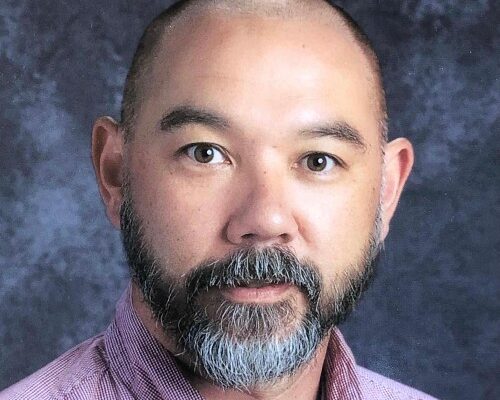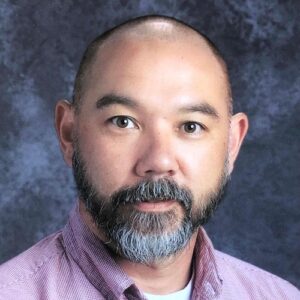
John Iwawaki
May 2021
 John Iwawaki is the District Instructional Specialist for West Contra Costa Unified, supporting science and college & career pathways for grades K-12 across the district. He’s been working in the district for over 20 years, and with CRS for over 5 years.
John Iwawaki is the District Instructional Specialist for West Contra Costa Unified, supporting science and college & career pathways for grades K-12 across the district. He’s been working in the district for over 20 years, and with CRS for over 5 years.
What led you to become a Science Specialist?
I’ve always loved being outside, nature and animals. I studied wildlife and fish in college. Then, I worked at a bank because I wanted something a little more stable. I accidentally ran into a friend, and she said “We need substitute teachers in West Contra Costa.” I was a substitute teacher for a year and I loved it. I looooooved it. So I got a teaching credential and became a science teacher.
Who inspired you along the way?
Teachers I’ve worked alongside, people who love teaching and being innovators, and really sparking interest in the kids. That’s my favorite thing– to see a kid’s eyes light up filled with wonder or that moment when a concept clicks. There’s no feeling really like that.
What brings you a sense of wonder in your work?
Being outside. Even just yesterday I was out in our garden and the poppies are growing and the bees come everyday. I found myself distracted, watching what was going on, seeing the life cycle of a poppy. Those flowers are there for a day and then they’re gone. That stuff is exciting to me and I love to share that. I love to help people notice things that are happening when I’m outside looking around. That’s what’s inspiring to me.
I taught at one school for a long time that closed and I moved to another school where kids didn’t have access to the same resources and have the same experiences that I was making the mistake of assuming that everyone had. That was really eye opening to me.
CRS has provided kids in our district a chance to touch and hold and see things, whether it’s a brain, a seed, or a cart on a ramp. I really appreciate CRS for really bringing science and examples to our kids and that’s something I really want to do.
How do you incorporate wonder into your work?
In 1999, I started a program called The Escape Club at the middle school I was working at and we have been taking kids outside on field trips once a month for 20 years now. We’ve gone on over one hundred field trips now. I love taking kids outside but even in the classroom showing kids videos or demonstrating things, phenomena based instruction. We can share with kids what’s going on and have them wonder about “What’s happening?” or “How does that work?” “What are the mechanics of it?” “How can I explain that?” That works at any grade level.
A kindergartner can appreciate a science phenomenon at one level, a fifth grader can explain it a little better, an eighth grader a little better, an eleventh grader a little better. We can always appreciate and wonder about the phenomena that’s happening.That’s what I love about science and being a science teacher. It’s what scientists do, notice things and wonder about it and say “How can I fix that?” “How can I make it better?” “How can I explain that?” They wonder about things and try to investigate it.
Describe a discovery you’ve made.
The ability to notice things and wonder about them and dig a little deeper. When I see something or share a video, [I] wait and let students come up with their own noticings and wonderings. Sometimes we all just need a little nudge in some direction. “What do you think is happening here?” Those kinds of things–that’s what I do when I go outside and wonder about things. I would love to pass that ability onto kids as they walk around and see what’s going on around them.
Describe a goal you have.
I really want teachers to be a part of the process in making students into scientists. One of my goals is to get teachers to be investigators with students. Even for teachers that don’t have a science background. Sometimes as adults it’s hard to say “I don’t know.” I would love for all teachers in our district, regardless of how much they “know about science” to wonder with kids.
The goal I have for all of our teachers is to make our kids scientists, to teach them how to be a scientist, more than just learning facts about science. I love facts about science, science trivia, those things are great, but I really want our kids to notice and wonder and learn those skills that scientists have: collecting evidence, collecting data, analyzing data, even asking questions. That’s the goal I have for myself, our teachers, and for our students.
How does working with CRS help you achieve your goal?
CRS has been a great partner with us at the elementary level. They’ve provided PD for us, they work with our teachers, not only for one or two hours, but their follow up is great. They stay in touch, communicate with teachers. They continue to provide resources, whether that’s by pushing out emails or developing their websites, it’s always one of my first go-to spots. A principal was saying, “Hey, do you know any resources for Spanish?” and I went to the CRS website and there’s just a whole page of science resources for Spanish. Sometimes it’s providing materials, even in distance learning, we’ve worked together to create little packets to send home with kids so they can experience science hands-on, even at home. I really appreciate CRS for working with us in West Contra Costa and sharing the same goals that we have and really driving our teachers to appreciate science and get a handle on what NGSS looks like and bring science to our kids. It’s always a struggle to compete with Math and ELA and squeeze science in but CRS has always been a great partner in empowering our teachers to bring science to kids.